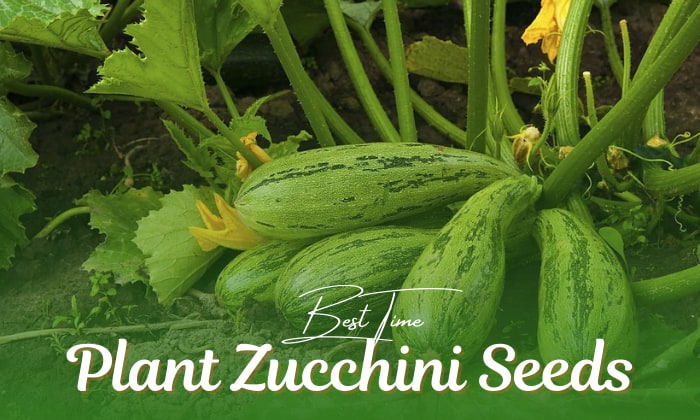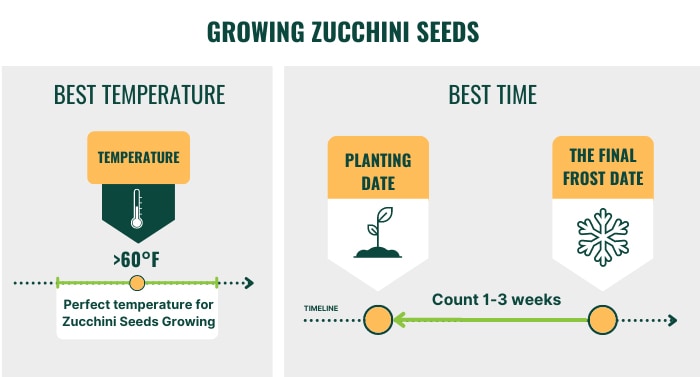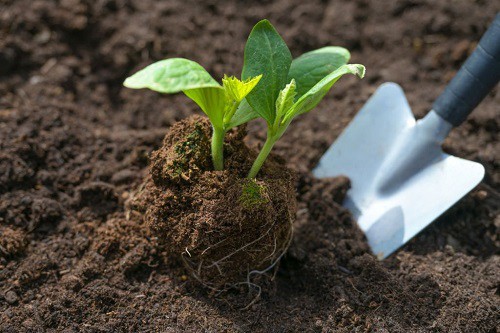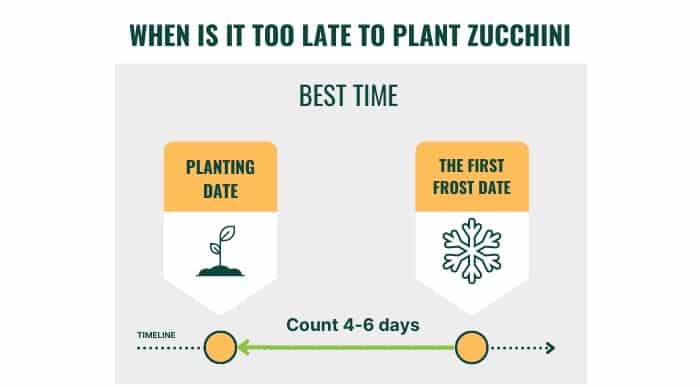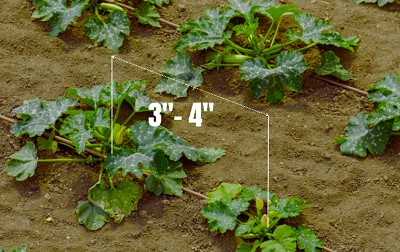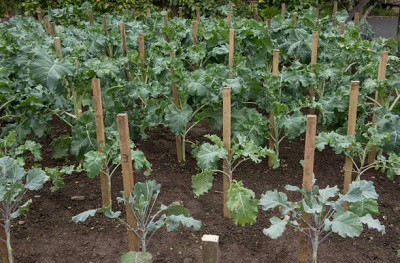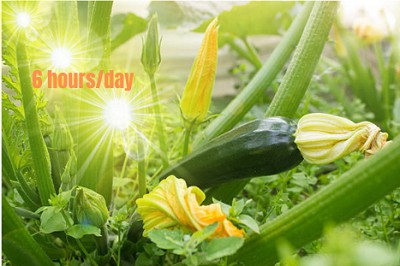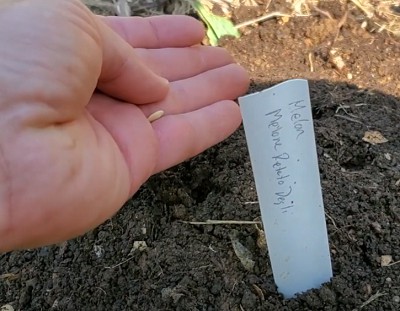Welcome to the world of gardening! If you’re eager to grow your own zucchini, knowing when to plant zucchini seeds is essential. Timing is key when you aim for a successful and fruitful harvest.
Zucchinis are warm-season crops, so late spring from March to May or early fall around mid-July to August is their best growing season!
We’ll explore factors that influence the ideal time for growing zucchini, so get ready to embark on a journey of planting and reaping the delicious rewards of your efforts!
Table of Contents
The Best Time to Plant Zucchini Seeds
Zucchinis are most vulnerable and weak during frosty or very cold weather conditions. Planting them during this time of the year would only result in an unfruitful harvest.
Temperatures that go from 32 degrees F and below are definitely your zucchini’s enemy. So being thorough in checking the climate condition is definitely a must for planting success.
1. When to Plant Zucchinis Indoors and Outside
When planting zucchini seeds, you may start them indoors prior to outdoor planting. Sow the seeds one to three weeks before the final frost.
After they have grown indoors for two to four weeks, you may start transplanting them outside after a week or three after your area’s last frost date.
However, soil temperature must also be monitored during this process. You may opt to use a thermometer to check whether the ground is still too cold for your zucchini seedlings. A recommended temperature would be above 60 degrees Fahrenheit.
2. When to Plant Zucchinis Based on Zones
While it is crucial to know the best time to plant these crops, it would also depend on where you are planting them. Each planting zone has its own climate and will definitely affect the growth of your summer squash.
Here is a summary of each planting zone for zucchinis and their gardening dates!
| Zone | Estimated Last Frost Date | When to Plant Indoors In Spring | When to Plant Outdoors In Spring |
| Zone 3 | May 1 to May 16 | April 10 to April 25 | May 8 to May 23 or later |
| Zone 4 | April 24 to May 12 | April 3 to April 21 | May 1 to May 19 or later |
| Zone 5 | April 7 t0 April 30 | March 17 to April 9 | April 14 to May 7 or later |
| Zone 6 | April 1 t0 April 21 | March 11 to March 31 | April 8 to April 28 or later |
| Zone 7 | March 22 to April 3 | March 1 to March 7 | March 29 to April 10 or later |
| Zone 8 | March 13 to March 28 | February 21 to February 26 | March 20 to April 4 or later |
| Zone 9 | February 6 to February 28 | January 16 to February 7 | February 13 to March 6 or later |
When is it too late?
With zucchinis being warm-season crops, they thrive under warm temperatures, and it would definitely be too late to plant them when there are chances of frost approaching.
Hence, you may apply the following recommendations:
- Plant four to six weeks prior to the first frost or earlier to allow the plant to develop and establish its roots.
- You may opt to give them protection through the use of row covers to make sure the plants stay warm.
Depending on the type of zucchini you are planting, it would take 40 to 70 days to reach its full-grown state.
7 Tips for Successful Zucchini Seed Planting
1. Planting Zucchinis in “Hills”
You’re probably wondering what we mean by “hills”. This is when you are transplanting zucchini seedlings outside in elevated heaps of soil. The hills will warm the plant better if they’re six inches high and twelve inches wide.
The warmth will encourage your zucchinis to develop more quickly while giving it more air circulation as well as drainage, making it an ideal growing environment for your plant.
2. The Right Amount of Room
Gardeners must always consider plant spacing, since this plays a big part in the growth of zucchinis. Once they have matured and started to grow their leaves, the other plants may be too close that the space will become too tight.
It’s recommended that you give them a distance of three to four inches, so they can breathe and grow to their utmost potential!
3. Give Appropriate Support
It is actually possible to grow your zucchinis vertically, and there are lots of benefits in doing so. For one, there will be more space in your garden! With it, you can reduce the risks of soil-borne diseases while increasing air circulation.
You may do this by placing the plants on a stake or putting them on a trellis after your zucchinis have been planted or once they have started to sprout.
4. Adequate Watering
Water requirements for zucchini plants vary, depending on where they are. However, general guidelines would recommend that you water your zucchinis weekly with a minimum of an inch of moisture.
But if you placed them in pots, in containers, or situated them in a raised bed, it will be better to irrigate the soil whenever the top two inches are dry.
5. Providing Direct Sunlight
Zucchinis have a hunger for full sunlight, which means they require 6 hours of it every day. These crops receive the most sun when they are planted in southern and western areas.
6. Directly Sow Your Seeds
This gives them a better environment for growth. Doing so would require planting a minimum of two or three seeds under the ground at a depth of an inch.
When watering, make sure you don’t apply harsh pressures onto the seeds. This could lead to them digging themselves further into the ground, because remember, they need to be at most an inch below the ground, not beyond that.
7. Provide Good-Quality Soil
Good-quality soil is well-drained and moist but not waterlogged and is rich in organic matter or compost.
You must prepare the soil in advance before planting your zucchini seeds directly into the ground. If you have heavy clay ground, plant care using coconut coir is essential, as it will lighten the soil and aid in moisture retention.
Conclusion
You must take note of when to plant zucchini seeds and consider the climate and region in which you are residing. Their successful growth would rely on the soil temperature, proper soil preparation, spacing, watering, and sunlight.
As sun-loving crops, zucchinis benefit from being planted in late spring and early summer. So you must remember to sow them directly in these seasons.
Once you have finished all the steps there are to take, you’ll certainly be rewarded for your efforts. These things take time and are quite a challenge. May you have fun planting as you harvest zucchini in the end!

Hello, my name is Dorian Goodwin and I have worked as a gardener and groundskeeper for the past 12 years. You can count on me for expert guidance on how to care for your garden. Creating a lush lawn for your front yard or growing an array of colorful flowers for your garden is a labor of love that I fully appreciate. And I am here to help.


